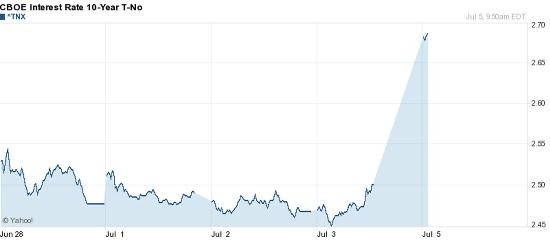Don’t dump your bonds when interest rates rise
Post on: 30 Январь, 2017 No Comment

MarkHulbert
Bloomberg
Janet Yellen and the Federal Reserve will be tapering its bond purchases and raising interest rates, leading to lower prices for bonds. Should investors dump bonds? Mark Hulbert explains why it’s not a no-brainer.
It’s a no-brainer, right? Owning bonds is bad when interest rates are on the rise.
Not so fast.
A review of past rising-rate periods shows that bond investments performed surprisingly well. So don’t be too eager to let the fear of higher rates lead you to sell your bonds and move into assets — such as gold — often billed as providing protection during such times.
To be sure, predictions of higher interest rates have been common for quite some time, and so far increases have been quite modest. But many investors continue to believe that average rates over the next five to 10 years will be much higher than they have been in recent years.
So just how poorly would bonds perform in a rising-rate environment? Consider the performance from 1966 through 1981 of a portfolio of intermediate-term U.S. government bonds — those with five-year maturities. That period, during which the five-year Treasury’s yield tripled, is thought by many to be one of the worst in U.S. history for bonds.
Yet, according to Ibbotson Associates data, such a portfolio produced a 5.8% annualized return in that period.
The Case for Adjustable Rate Mortgages
Conventional wisdom says fixed-rate is better, but Simon Constable tells Jack Otter that adjustable makes more sense, especially for high-net-worth families.
How? The answer lies in the increasing yield the portfolio earned as bonds matured and the proceeds were reinvested at higher interest rates — more than making up for the losses of the bonds themselves that those higher rates caused.
This result isn’t a fluke of the 1966-81 period, according to a study appearing in the January-February issue of the Financial Analysts Journal. The authors — Martin Leibowitz and Anthony Bova, managing director and executive director at Morgan Stanley, respectively, and Stanley Kogelman, a principal at New York-based investment-advisory firm Advanced Portfolio Management — found that, as a general rule, the greater yield earned during a rising-rate environment offsets the declining bond prices those rates cause.

Bond investors “need not be unduly worried about the impact of higher rates on their multiyear returns,” they concluded.
What about gold US:GCM4 ?
The World Gold Council argues that investors should consider the metal as a protection against rising rates. The council, which represents the industry, said in a recent report that a stock-bond portfolio that also owns gold delivers higher risk-adjusted performance than a portfolio that owns stocks and bonds alone.
Juan Carlos Artigas, the group’s director of investment research, said in an interview that the conclusion is highly dependent on assumptions about how each investment will behave in the future — not only its performance, but also on the extent to which it is correlated with other investments.
One of the group’s most crucial assumptions, Artigas says, is that the outlook for bonds in coming years is poor. In that case, he says, replacing five to 10 percentage points of the bond portion of your portfolio with gold would increase return without also increasing volatility.
Artigas says that his study didn’t fully account for the rising yield of a bond portfolio that continuously rolls over into new bonds, and that his “approach is perhaps not the most accurate.”














